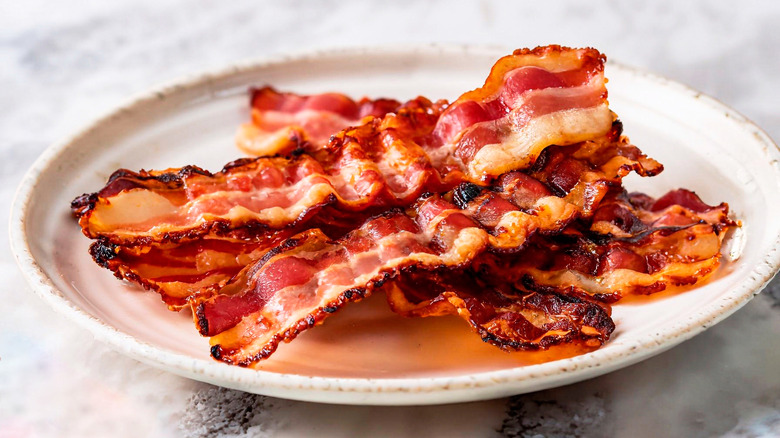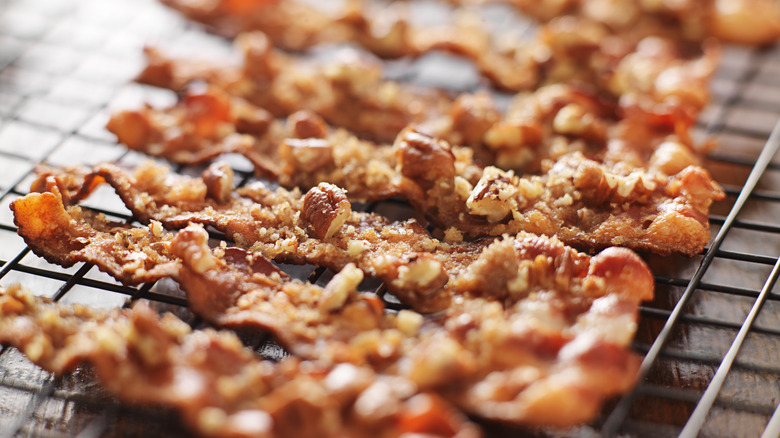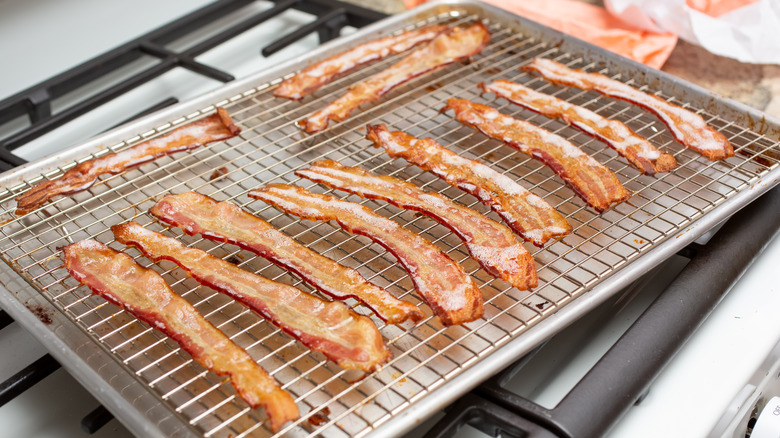Literally Elevate Your Crispy Bacon With One Common Kitchen Tool
It's not just conjecture — scientifically, bacon goes great with everything. That's because its salty flavor brings out the best in whatever it's paired with, be that a sweet, maple-infused treat or a hearty, protein-packed meal. One of the easiest ways to cook up a slab of bacon is to bake it in the oven until it reaches your desired level of doneness, but this method isn't perfect.
When bacon is cooked flat on a baking sheet, the rendered fat can pool and prevent the bacon from becoming as crispy as possible. Along with hindering the cooking process, this can waste precious bacon fat, which might otherwise have been collected for later use. This method can also make quite a mess, especially if you use parchment paper that might let the liquid fat seep through to the baking sheet underneath. Thankfully, you can avoid all of these problems with the help of a wire cooking rack.
The next time you have a hankering for some bacon, set yourself up for a quick and easy cooking process by first covering a baking sheet with aluminum foil. Make sure to use a sheet that has a raised lip so that it can collect all the bacon fat. Then, simply put an oven-safe wire rack on top, and drape a layer of bacon over that for perfectly crispy results.
Wire racks make bacon crispier
As the bacon cooks on the wire rack, the fat will drip down onto the foil instead of collecting on the bacon itself. Additionally, since the bacon is slightly raised, it's able to receive convectional heat on both sides rather than being half cooked by direct heat from the pan. This means a more even, crispy cook throughout. The optimal cooking temperature for bacon will vary depending on your oven and personal preferences, but 400 degrees Fahrenheit for about 20 minutes is a good place to start. Afterwards, be sure to store the bacon so it stays crispy.
One huge advantage to putting the wire rack over aluminum foil is that once the bacon is done cooking, you can collect the leftover bacon fat without much fuss. Wait for the grease to cool down a bit (don't wait too long or it might be harder to work with), then carefully transfer it to a resealable plastic container. With a bit of maneuvering, you should be able to form the aluminum foil into a sort of slide to make moving the bacon fat easier. If you were able to make a solid layer of foil, the baking sheet should be completely clean.
Cleaning the wire rack and other tips
If you do start adopting this wire rack technique, just be prepared to clean it regularly. Depending on how often you cook bacon and the style of your wire rack, it can collect burnt bacon bits in the nook and crannies. It's not too difficult to clean, and you can wash it in tandem with your baking sheet. Fill the baking sheet with hot water and some dish soap, and submerge the wire rack in it for a few minutes. Then, you can use a stiff-bristle brush to get rid of any debris before popping it in the dishwasher (as long as your model is dishwasher safe).
As for the excess bacon fat that you'll start collecting, use it as you would any other cooking oil. Use it as a base for soup or gravy to give your dishes a bit of extra smoky salty flavor, or use it to fry up some eggs and hash browns for a bacon-blasted breakfast. If you're not into red meat, you can also cook turkey bacon on a wire rack, though it might not produce as much oil. No matter how you like your bacon, cooking it this way will definitely elevate it. Combine this hack with these other tips for cooking bacon in the oven, and you'll be whipping up delicious diner-level bacon at home in no time.


